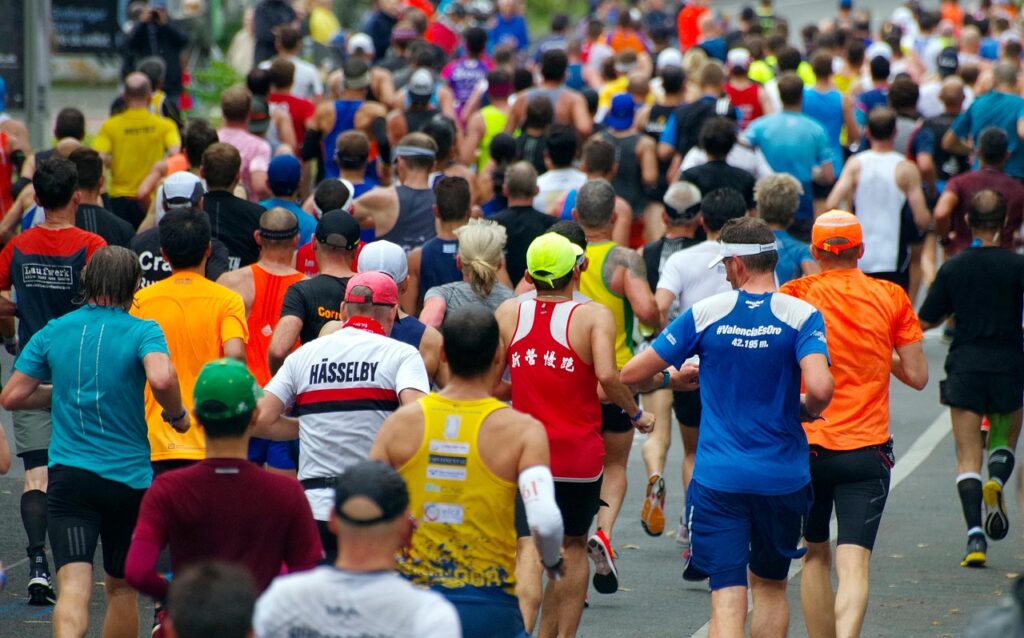
Image by wal_172619 from Pixabay
This evening, I registered for my first 10K race: the Vancouver Sun Run, scheduled for April 19, 2029. This will be my first track event since high school. While I was never much of an athlete, I have been on the path of continuous and ever-improving fitness this year. Committing to a 10K run is not only a continuation of that journey but also a decision that marks a new chapter in my health and fitness journey. This race isn’t just a goal; it’s a statement of intent. I’m ready to push boundaries, challenge assumptions, and see what I’m capable of when I commit fully.
Why I Chose the 10K Distance
The 10K is a compelling challenge. It’s long enough to require serious preparation, but short enough to be achievable for a first-time runner (which I am) with a structured plan. For someone like me — focused on metabolic health and strength training — it offers a new dimension to my fitness routine. It’s not just about endurance; it’s about discipline, consistency, and the ability to adapt.
Running had never been a central part of my life. In fact, until recently, I was of the opinion that I cannot run. That changed on December 30, 2025, when I went for my first run in over 40 years. Yes, it was on a treadmill. Yes, it was short, slow, and humbling — but it was also transformative. That single run reignited something in me: a desire to move, to challenge myself, and to reconnect with my body in a new way.
Since then, I’ve built up to running 6 kilometers in 57 minutes — a pace of roughly 9:30 per kilometer. It’s a solid foundation, especially considering where I started. But my goal for the Vancouver Sun Run is ambitious: I want to complete the 10K in 55 minutes. That means sustaining a pace of 5:30 per kilometer — nearly twice as fast as my current pace, over a longer distance. It’s a stretch, but I believe it’s within reach.
Starting Where I Am
My current training includes steady state running and strength work. I’m not doing much stretching or mobility work yet — something I know I’ll need to address as the mileage increases. For now, the focus is on building aerobic capacity, improving muscular endurance, and staying injury-free.
Until recently, I wasn’t especially meticulous about nutrition. I ate reasonably well, but I wasn’t tracking closely or tailoring my intake to support performance or blood sugar control. Since September, I’ve made a deliberate shift: reducing fast-digesting carbohydrates and increasing my intake of fiber and protein. This change has had a noticeable impact — more stable energy levels, fewer post-meal glucose spikes, and better satiety throughout the day. I have also lost seven pounds in the bargain.
I now focus on meals built around legumes, vegetables, whole grains, nuts, and lean proteins. I’ve also become more aware of micronutrient adequacy — especially vitamin D, calcium, magnesium, folate, and vitamin A — all of which support energy metabolism, muscle function, and recovery. These nutrients are especially important for someone managing insulin sensitivity and metabolic health.
Week 1: Establishing the Rhythm
The first week of training will be all about consistency. I’ve scheduled three steady-state runs, two strength training sessions, and two active recovery days. The runs will be short — 30-40 minutes — at a conversational pace. I’m not trying to push hard out of the gate. I’m building a foundation that will support me through the next five months.
There’s a mental shift happening too. Registering for the race has created a sense of accountability. I’m no longer just “thinking about running more.” I have a date on the calendar, a bib number waiting, and a finish line to cross. That clarity is motivating. It turns vague intentions into concrete actions.
Here are some other things I will be working on:
- Pacing will be critical. It’s easy to start too fast and burn out early. I will not get too excited and amp up my routine drastically. Rather, I will hold back and stay aerobic.
- My calves are tight. They’re not used to this kind of repetitive impact. I will incorporate foam rolling as well as stretching and mobility work.
- Sleep is critical to optimum performance. I will get at 7.5 to 8 hours of sleep every night.
I will be logging my runs with my Garmin Vivoactive 4 to track distance, pace, and heart rate. The data will help me stay objective and adjust my effort based on performance rather than perception.
Nutrition and Recovery
Since September, my approach to nutrition has become far more intentional. I’ve reduced refined carbs and focused on foods that support stable blood sugar and sustained energy. Lentils, chickpeas, oats, chia seeds, tofu, leafy greens, and berries now make regular appearances in my meals. I’ve also increased my protein intake to support muscle repair and satiety — especially important on training days.
Going forward, I will prioritize hydration, especially on longer training days. Electrolyte balance will become more important as the runs get longer and the weather warms up.
I’m also paying attention to glycemic load — choosing foods that support stable blood sugar before and after runs. I track my blood glucose using a continuous glucose monitor (Freestyle Libre 2) to understand how different foods and intensities affect my body. This data helps me fine-tune my fueling strategy and avoid energy crashes.
Mindset and Motivation
Running is as much about mindset as it is about mechanics. There are moments — even in short runs — when my brain says, “You can stop now.” Learning to override that voice, to stay present and focused, is a skill I’m actively developing.
I will also be visualizing race day, with me at the starting line, surrounded by thousands of runners, and soaking in the energy, the excitement, and the challenge ahead. I will see myself pacing steadily, breathing rhythmically, and crossing the finish line strong. Visualization will help me stay motivated and remind me why I’m doing this.
Looking Ahead
Over the next few weeks, I’ll gradually increase my running duration and total weekly mileage. By the end of month one, I hope to be running continuously in zone 2 for 75 minutes. From there, I’ll start incorporating tempo runs, hill repeats, and longer weekend efforts.
I’m planning a 5K time trial around week 8 to gauge my progress and adjust my pacing goals. If all goes well, I’ll aim to complete the 10K in 55 minutes — a pace of 5:30 per kilometer. It’s an aggressive target given my current 6K time, but I’m committed to training smart and pushing myself.
I’ll also be adding mobility work — dynamic stretches before runs and static stretches afterward. I’ve neglected this in the past, but I know it’s essential for injury prevention and recovery. I’ll be focusing on hip flexors, hamstrings, calves, and ankles — all areas that take a beating during distance running.
Why I’m Blogging This
I will blog about my training, nutrition, and sleep at the end of each day. Not just the stats, but how I felt, what I noticed, and what I want to improve. It will help me stay connected to the process and recognize patterns — both good and bad.
Part of the reason I’m documenting this journey is to stay accountable. But it’s also to share the real experience of training for a 10K as a beginner — and as someone managing diabetes. There will be good days and bad days. There will be setbacks, sore muscles, and missed workouts. But there will also be breakthroughs, quiet wins, and the satisfaction of showing up consistently.
I want this blog to be honest, practical, and relatable. I’m not chasing perfection — I’m chasing progress. I’ll be sharing weekly updates, including training stats, nutrition tweaks, mindset shifts, and reflections on what’s working and what’s not.
If you’re reading this and considering your own fitness challenge — whether it’s a 5K, a hike, or just walking more — I hope this blog gives you a sense of what the process looks like. Not the highlight reel, but the day-to-day reality.
Final Thoughts
Signing up for the Vancouver Sun Run is more than just a race registration. It’s a commitment to growth, discipline, and self-discovery. It’s a way to test my limits, learn new skills, and deepen my understanding of what it means to train with purpose.
I’m approaching this journey with curiosity and humility. I know there will be setbacks. I know there will be days when I don’t feel like running. But I also know that every step I take brings me closer to a stronger, healthier version of myself.
Thanks for following along. I’ll be back tomorrow with my first full training recap — including what worked, what didn’t, and what I’m adjusting. Until then, onward.
